#also do not go to the echo wiki just in general if you like horror VNs please i am begging you
Explore tagged Tumblr posts
Text

heartwarming to see how people feel about the MC of echo:)
#this is so so funny to me sorry HGKSHGH#also do not go to the echo wiki just in general if you like horror VNs please i am begging you#play the game it's free!!! or watch keith ballard's LP!!!!!!#linatxt
16 notes
·
View notes
Text
Troy Calypso/Reader: Non-specific SFW and NSFW headcanons

>Masterpost | >Request Info
SFW
General
He is the possessive and obsessive type. Mostly because of his deep desire to be recognized, to be the only one in someone’s life for one and because of his insecurities, obviously. It's like finally getting his very first toy that belongs to him only, but in a more profound way. It just makes something snap in him, there’s finally something else he’s actually willing to fight for. Even being in a platonic relationship with him is rocky sometimes because he just won’t let you take a breather from his presence. I wouldn’t say Troy is a psycho-stalker-yandere-boyfriend (though stalker is not a word I’m averse to using in his case) because he has other things to worry about and also, funny enough, he wants it to be the only thing in his life that is just normal, but he WILL be going around threatening people and maybe killing someone occasionally if they did or said something.
This being said, I think he’s more into pursuing someone rather than being pursued because, due to years of neglect and living in the shadow of his sister, someone genuinely chasing him to build something real with him just throws Troy off. Not saying it won’t work entirely, but it’ll definitely take more time to accept it.
Annoying. Troy takes pleasure in getting any kinds of reactions out of you in a way that kinda resembles a teenager pestering his crush, lmao. Bear with him a little, he’s never had the chance to grow out of this phase because he’s never even been to middle- or highschool.
Good at remembering stuff about you. Especially if you’ve never even mentioned liking or doing something to him. He just knows. Look, it’s not weird he happened to overhear something over your ECHO or did research, okay?
Looks and acts like a soggy lovesick puppy sometimes despite the bravado, the God complex and his creepy, murderous tendencies.
Gets really fucking bold and imposing with his advances if you haven’t established anything before he acquired Maya’s siren powers for one reason or another. Almost scarily so. Power-high and all that. But it’s a thought for another h/c post or another 4K-worder, lol.
Vault Hunter Crush / S/O
CRAZY parasocial relationship on his part. The more this whole thing transcends the realm of it being an ironic ongoing gag where he pretends to fawn over a badass, brave VH (bonus points if, in reality, you’re the least capable, popular and/or mouthy of the bunch and he just thought it would be hilarious) for shits and giggles the more he actually looks like a fan.
Pales in horror once he realizes what is going on. Both because it makes things far too complicated and because it’s apparently “cringe”. Doesn’t even want to think about what his sister would say to this, although Tyreen for sure has known from the start. Gets anxious during major plot points of the game because he knows what comes next and how many followers they’ve sent after the Vault Hunters.
May have bought or made some merch. Mayhaps curates your wiki page.
Messages you from a couple of alternative accounts and anonymously sends little gifts. “From a fan! ;)”
I just keep thinking about how he reminds me of interactions with Lucas Baker. Now THAT’S the king of fucking with you and antagonizing from afar, and his part of the game is something what I would’ve wanted for Troy. Which is closely interacting with the player. Lucas literally built a whole escape room and a death game so he could torture the MCs for funsies. It would also be in-character for Troy to come up with an elaborate plan of how he could lure you out so he could get in close and maybe play with you a little. Nothing too dangerous, ofc. Well, maybe a little dangerous. Eh… just dangerous. But he’ll surely come to rescue!
COV member Crush / S/O
Has scared you out of your mind more times than it's necessary in the beginning of you working for the cult because he thinks it’s funny. Still applies to him being annoying to get your attention because he’s a troll and also kinda pitiful (hot). Everything also starts from a harmless crush or curiosity.
Blatantly demands your attention and gets all giddy when you want to hang out. Troy’s the type to whine if you say you have to go do something/complete a task Tyreen gives you mid hang out (or mid whatever amount of time he deems enough for him to be satisfied when you’re around). “What? Are you fucking kidding me? Already? No, no, stay longer, I want you to stay.” It’s especially bad if you’re cuddling or making out when the ECHO dings. He’s just not letting you go anywhere, plain and simple.
Every cult party is a struggle. A struggle to get him off of you? Fans off of him? Him off of the throats of men that hit on you? To manage both Tyreen and Troy actively seeking out your affections? Perhaps all of the above.
NSFW
This one may be weird to some but honestly… who cares…
Four words: Troy is a pervert. Thanks to many factors like finally being able to express and explore himself. Plus the game kinda actively poses the twins as sexually frustrated young people. Considering what the majority of Typhon’s logs sound like… It’s probably written in their DNA.
Has touched himself on call with you more times than he cares to admit. You’ll probably never know he does, due to him mastering keeping his voice in check, unless he wants to be discovered or slips up badly. The prospect of you catching on and the riskiness of it all just get his blood pumping. Same goes to him secretly using toys in public or during streams sometimes. He’s just depraved like that. Although he can give you the remote if you want.
“Insert to cuck” written next to one of the ports on C.H.A.Z. is probably just an edgy joke but I do believe he’s a voyeurist who occasionally uses surveillance to jerk off. And if we’re getting into other design choices… The D-ring being present on his collar/choker and absent on Tyreen’s is obviously a way to show him as the one who’s being led or guided out of the two, but hey… It doesn’t mean you can’t leash him anyway. He loves it.
“Explore each other’s bodies” at its finest. Though he's the one doing the exploring and watching for the most part. Troy would ask to see you naked in person even outside of a romantic relationship if he finds you attractive and gets the right opportunity. That’s what friends do, no? This mostly goes to him before Promethea and Eden-6. Just indulging in his desire to experience intimacy with someone he trusts. If you don’t immediately say no to the idea he almost orders you to sit on the computer desk and strip so he could see everything better from his chair. While you’re undressing, he casually watches, lets his hands wander or palms himself through the pants. All that until Troy gets so desperate to see and feel more he suggests he fingers you or something. And he just won’t stop commenting on everything while knuckle-deep in you even if you ask him to.
25 notes
·
View notes
Text
meta: pendragon paranoia (aka the brainwashing of Arthur Pendragon)

Quick summary: Uther seriously fucked up Arthur’s head when he was a boy, brainwashing an abiding fear of magic in his son (selfishly to ensure that Arthur could never repeal the magic ban on his own). The subsequent suspicion Arthur harbours towards the magical community is deep-rooted, although he doesn’t share the same hatred of sorcerers as his father. However he can and will turn extremely hostile should he feel magic is threatening the kingdom he loves and the people he has sworn to protect.
RP Relevance: So I’ve got a dedicated verse for Arthur going bad like his father. It’s here. So unless something is already plotted looking at a certain someone anything truly dark and nasty with the muse will probably go in there.
Addendum: You (hopefully) won’t see me RP this side of Arthur very often. The situation has to be complex enough to involve a large number of triggers to push Arthur (who is still one of the good guys) into this mindset. But I will continue to occasionally reference it in RPs throughout the verses because it’s there in my Arthur’s psyche. We can’t just cut out and/or ignore the nastier side of his upbringing by Uther.
This summary ought to do with a bit of unpacking though. Ok, let’s get the definition up (from good old Wiki)
Paranoia is an instinct or thought process which is believed to be heavily influenced by anxiety or fear, often to the point of delusion and irrationality. Paranoid thinking typically includes persecutory, or beliefs of conspiracy concerning a perceived threat towards oneself (i.e. “Everyone is out to get me”). Paranoia is distinct from phobias, which also involve irrational fear, but usually no blame. Making false accusations and the general distrust of other people also frequently accompany paranoia. For example, an incident most people would view as an accident or coincidence, a paranoid person might believe was intentional. Paranoia is a central symptom of psychosis.
... that was a long definition, sorry. But it’s a useful reference point going forward.
Arthur Pendragon is a psychological mess. He hides it very well as a good prince / king / leader of the people must, but it’s still there.
Most of that is due to the huge amount of stress he is under to live up to a high level of expectations. To Uther, he’s the Crown Prince of Camelot and heir of the Pendragon dynasty. To Merlin, he’s the Once and Future King with that great big destiny to fulfil. To the people of Camelot, he is their Champion and Protector. He is literally the one who keeps them all safe at night. That is a lot of responsibility and pressure for anybody at any age. Which... is the reason why I headcanon Arthur indulges in sex quite a bit. Poor boy simply needs the release.
Sometimes, Arthur just wants to take a break from it all and go off to live on a farm with his girlfriend and manservant.

But Uther is a very controlling father.
Arthur is not allowed to just leave. Uther has invested a lot (e.g sacrificed his own wife) into getting what he wants, and that is a son and heir worthy to continue his legacy. Now he has to make sure the investment pays off.
So Uther made his own plans for Arthur, putting him through intensive knight training from birth to ensure he became the greatest warrior of the five kingdoms. He also organised an arranged marriage for Arthur when he is old enough to further cement Camelot’s position. Throughout it all, he was trying to mould his son into becoming the king he wanted him to be. It was about making sure Uther’s legacy following the Purges was upheld and that Camelot’s laws forbidding sorcery prevailed. Arthur could not show any signs of deviating from Uther’s vision on this point. In the final push, Uther had to make sure his son not only acted in the way he was expected to - but he also thought and behaved in the way he was supposed to as well.
And he could only guarantee that level of instinctive behaviour by making sure Arthur carried the same fear and suspicion of sorcery as he had. Because emotions cannot be so easily challenged and/or removed as misguided beliefs. Uther knew his conditioning would stay with Arthur, influencing his decisions long after he was gone. Even if on a conscious level Arthur later rejected his father’s teachings, even if he grew to resent what had been done to him - those warped feelings towards the magical community would remain. Uther’s brainwashing had already gone too deep.
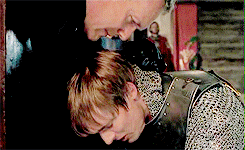
Arthur was always going to be an easy target for such abuse. He loved and respected his father. Uther was the only parent he had growing up. He had no other role model. Arthur would have readily absorbed any horror stories Uther told him about magic as gospel. He was probably only 7 years old when the emotional conditioning started.
In fact, I’ve already documented some of this childhood abuse already in RP. The warning signs have always been there.
Sorcerers. They are the worst kind of traitors known in our kingdom. You must be vigilant, Arthur. Do not allow them to influence your judgement. They’ll come to you, as a friend, promising to offer you help. And then they’ll take away the very thing that you love most in this world. That is why they cannot be trusted. That is why they must be hunted down and exterminated. All of them.
( x - RP with @aquestionthatsneverbeenposed )
Listen to me, Arthur. They are an evil people. You must never trust a sorcerer, nor lower your guard in their company. The laws of Camelot are the only force we have to save us from their depravity. Closing his eyes, Arthur can still hear the distinct echo of Uther’s voice in his head from all those years ago. Viciously imprinting his doctrine into the impressionable mind of a young blond boy.
( x - RP with @lespendragons )
There are plenty more examples scattered throughout my writing, but... you get the gist. I’ve also compiled a short list of some of the nasty things Arthur saw in the court of magic users abusing their powers and hurting his people here.
Right. So why did I choose to give the muse this gaping mental flaw that sets him up as a possible antagonist for future RP interactions? Besides some interesting narrative possibilities, of course.
Two reasons:
1. It goes some way to explain why Merlin in canon continues to withhold his secret from Arthur, even after Uther died.
2. It gives further insight into why Arthur has always been so desperate for his father’s approval. Arthur’s fear pushes him into a habit of turning to strong rulers, instead of relying on his own judgement. We see this behaviour throughout season 4, where Arthur seeks advice from Agravaine when his kingship is tested because in his paralysis he needs to be told by an authority figure what to do. We see it again in S5E3 where Arthur summons his father’s own damn ghost because he still needs Uther to tell him he’s doing the right thing for Camelot. The paranoia of his perceived enemies closing in around him drives him to seek that level of reassurance.
This is the Pendragon paranoia. It’s a major headcanon. The reason I’ve dedicated a whole meta to it is because it’s the biggest hurdle in the reformation of Arthur’s character for him to overcome if he’s to accept magic back into the kingdom.
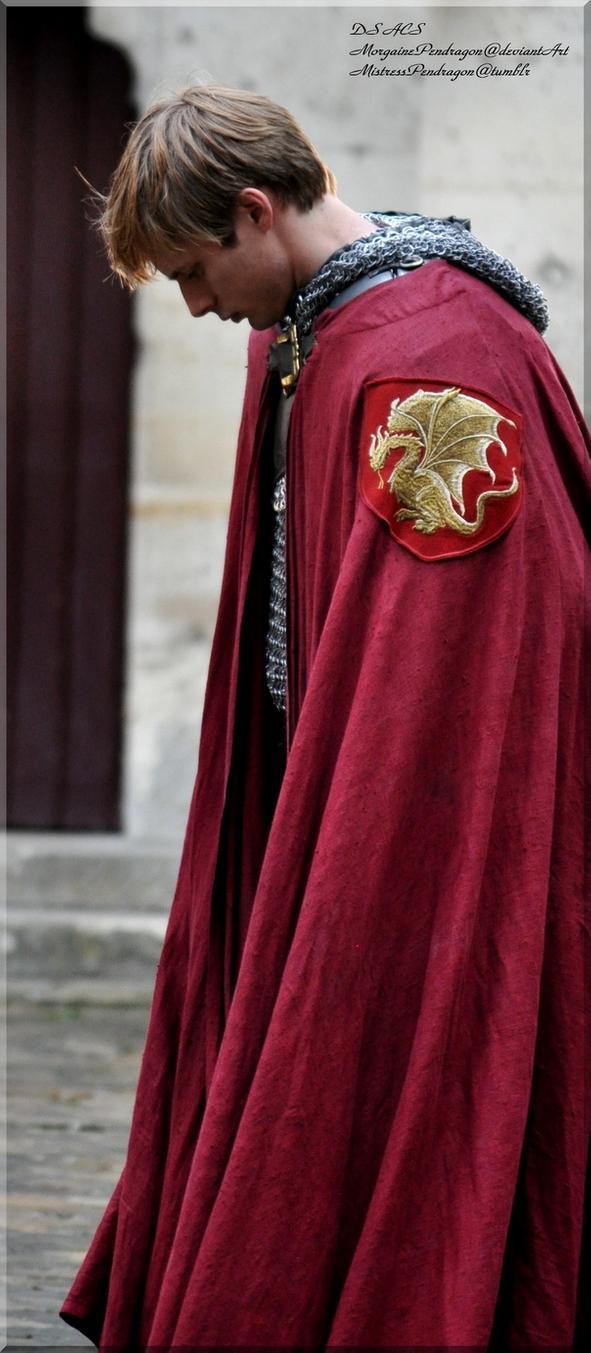
Arthur is not a saint, he’s a flawed hero. His weaknesses must be addressed if he’s to successfully become the King Arthur that Merlin and all our other protagonists aspire him to be. And Merlin in canon has already started this healing process with every conversation they have about how he’s different from his father, and that’s ok. There are other ways to be a strong ruler rather than simply following his father’s ingrained example.
Canon Arthur knows this, as does mine, and they both will/do get there in their respective understandings eventually. Just. Watch out for any dramas if things are pushed too quickly in that direction. And/or other events spiral out of control. Dark!Arthur is real and a potential consequence.
#Pendragon paranoia#Arthur Pendragon#Uther Pendragon#tw: mental health#tw: emotional manipulation#meta#//a bit long and ponderous but I have a lot of thoughts and feelings on this#//please don't hate my characterisation of Arthur too much *silent prayer for the fallen*#dark!Arthur#v. rex tremendae majestatis
6 notes
·
View notes
Text
The level design of V&A Design/Play/Disrupt
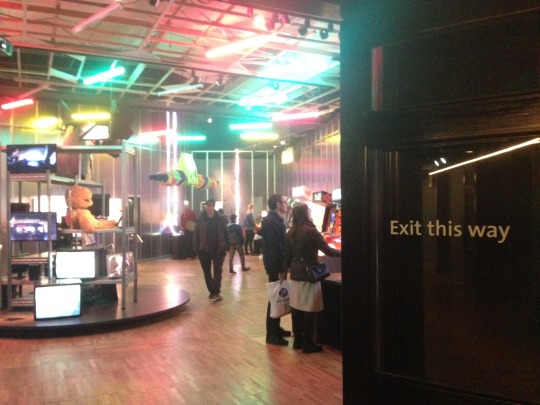
Recently went to the V&A expo on videogames and thought it might be fun to try and think about it’s ‘level design’. I realise its silly to call it that and is more informed by planning an exhibition/ event planning and architecture, but w/e.

[pictured: how do you Do it?, 2014 - Nina Freeman, Emmett Butler, Decky Coss, and Joni Kittaka]
This is mostly gonna be some simple thoughts on the experience of traversing the space of this exhibition, and how that space is used effectively to create different effects/ experiences, as well as notes on the smarter considerations on how the experience is paced/sequenced.
This warped/truncated/inaccurate/drawn from flawed memory map roughly shows the layout of the V&A expo:

The whole exhibition can be roughly broken up into four fairly distinct parts:
Exhibits of the design of different video games from differently sized studios ~2009 onwards. [blue]
Articles, talking points, video discussions and exhibits of games as part of our broader social context, concerned with violence, gender, sex, sexuality, race, language, protest etc. [orange]
A large video theatre showing some of the communities that form around games. [red]
An arcade showcasing several more experimental games and projects, that is open to free play. [yellow]
DESIGN
When you walk in you are greeted by a huge projector flashing between collages of the various exhibitions and the alternating titles DESIGN, PLAY, DISRUPT.
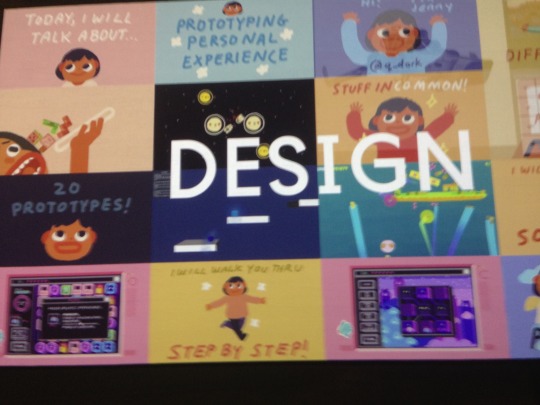
[pictured slides from Jenny Jiao Hsia’s talk on prototyping to make her game: ‘Consume Me’, 2016]
Seeing this is unavoidable when entering, and it serves as something of a banner to signal the transition into the formal exhibition space. YOU HAVE ENTERED THE WORLD OF THE VIDEO GAMES.
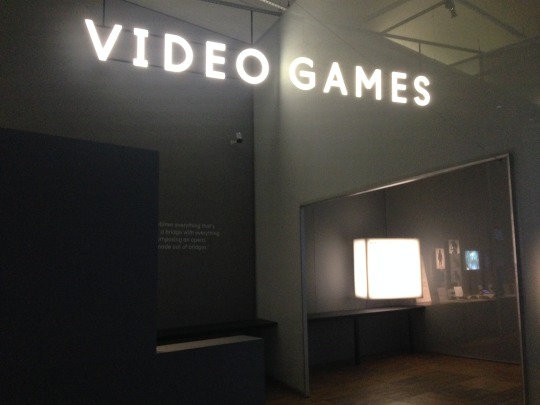
Mapping this first area of the 1. Design section of the exhibit we get something like this:
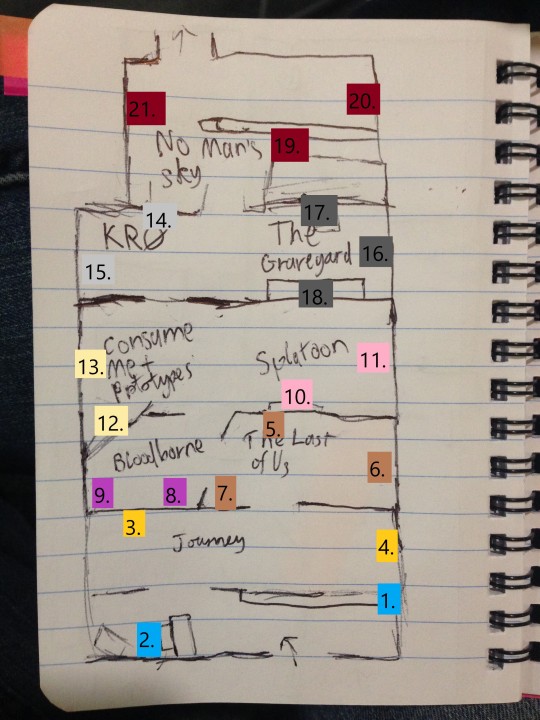
Note that these numbers are in an arbitrary order of roughly when I encountered them, and are not indicative of density, just general location of possibly several bits of each exhibit. Also this list is not exhaustive, nor is the map strictly accurate, I do not have an eidetic memory, but I do have a notebook and a smartphone.
Design/Play/DIsrupt screen
Large Print Text Binders
‘Journey’ gameplay montage projection
Notebooks, sketches, a headphone + video prototype demo, inspo photos/footage, graph and board of intended player journeys/narrative threads
‘Last of Us’ Dual screen demo showing gameplay and some of the work relevant to make that part of the game happen
Sketches, notebooks, board plotting out story events/setpieces in seasons, film made for atmosphere reference, blue sky concept art, colour scripts
Mocap footage +suit
Matt Lees @jam _sponge describing the anxious, excitable play of ‘Bloodborne’ between 3 screens.
Notebooks, sketches+concept art, level design docs, and SketchUp pics of early levels, headphones to listen to a recording of the soundtrack
Bunch of top designs for ‘Splatoon’
Early Prototype, creature sketches, fashion asset design
Playable prototypes from the making of Consume Me
Notebooks, corkboards, workplace ephemera, unity project demo, headphone + video 40 minute talk on prototypes
Music from ‘Kentucky Route Zero’ / KR0, visual representation of branching dialogue in twine, Margritte’s ‘Spring in the Forest’
Inspirations, typeface considerations, group wiki, twine showcase
Realtime Art Manifesto, Even more notebooks, with sketches and details of designing Tale of Tale’s ‘The Graveyard’
Playable demo of The Graveyard
Bench
Multi-screen montage of generated worlds in ‘No Man’s Sky’
Blueprint tool for spaceships, terrain debug tool, sci-fi inspirations
Visual inspirations
So what are some of the ways we can think about how this expo was laid out?

For a start it’s fairly linear, there are no branching paths at Design/Play/Disrupt, it’d be a layout ill-suited to somewhere like this where there’s a strong desire for the audience to see all the content and assets (the exhibits) and not miss any pieces that time was spent curating. Thankfully unlike some videogames, this linearity is not gated. There are no attendants fiendishly running up behind you and closing doors as you move from one game to another, people might have missed something, or want to visit an earlier piece while friends are preoccupied with something for a little longer.
Exhibits are visited for the most part in a defined order, with some freedom in the Kentucky Route Zero/Graveyard room as well as the Splatoon/Consume Me room. You are encouraged to experience what is on display for each work and are being guided in a deliberate order, as opposed to set loose in an open hall with no boundaries where some attendees might skip or miss a part of the exhibition.
One thing tying sections you can explore or skip is their loose thematic / tonal linking:

To put it another way, there is a good reason that Bloodborne is next to The Last of Us. Both are triple-A big budget, rated 16+, 18+ action games for blood guts and all the cheery stuff. Consume Me and Splatoon work well next to eachother as the cute aesthetic and playable prototypes hanging from the ceiling work well across from Nintendo’s colourful and playful Splatoon. It would be a bit less natural to have the grotesque and rapacious sounds of Bloodborne echoing within the exact same room as Splatoon. I’m not saying any of these works don’t have some commonality beyond the arbitrary border I’ve drawn, but they fit better together.
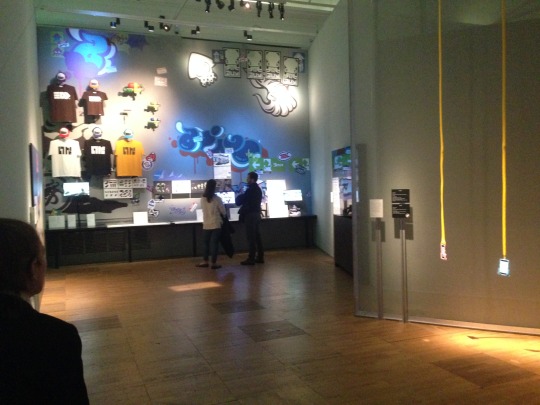
- Plus this open space invites an atmosphere of play after having just been cramped into two games rooms that feature horror elements
[Pictured: Splatoon’s section, as well as Consume Me minigame prototypes open to play, suspended from the ceiling]
This also showcases another thing about this event applicable to level design: the same space can be made appealing to different types of audiences. This is an exhibit about video games. I’ll admit this is just my gut but I’d be willing to bet that this exhibit is more likely to be attended by parents and their children than it would most other exhibits. I don’t know exactly what the V&A’s idea of the ideal attendant is, and that’s probably owed to the fact that this event catered to lots of different levels of assumed knowledge and engagement with videogames.
Parent’s who might be a little out of touch with mainstream games, are quite likely to have been put off by bringing their kid to something that was entirely wall to wall Bloodborne, Dark Souls and other things as frightening (as much as I personally would have enjoyed that). Standing watching a parent pull their rapt child away from dulcet descriptions of how deadly mistakes are, in the big monster game, the success of the exhibition is apparent; the next room is a bit more targeted towards that kid’s age range (even though they did seem pretty into Bloodborne).
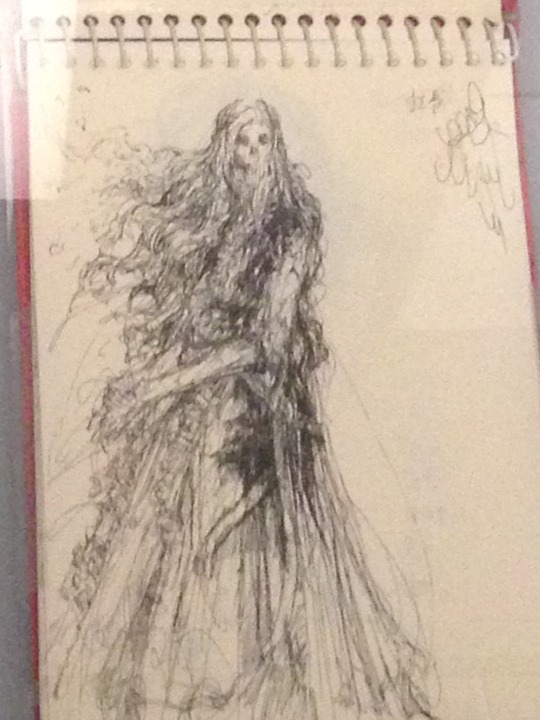
[The concept art from Bloodborne is such a treat]
It’s no surprise as well that the first game is not The Last of Us, but Journey. More people are playing games now than ever but there remains a fair few people who still don’t really know what’s going on in games. As an exhibition that in part is attempting to show the breadth and depth of games being designed, it makes sense that the first introduction to what games are being made is a game without much in the way of traditional combative interaction.
To wafflingly reiterate: the sequence of how things were placed matters: The accessibility options: 2. [Large Print Binders] are available at the start. Benches and places to sit are placed later throughout the exhibit (including rather wittily across from The Graveyard; a game where the entire goal is to make an old woman sit on a bench).
Reinforcing this point of how the same space can be made to cater to different people this event was extremely Multimedia. Explanations of parts each games design process written up, sketchbooks, and lots of different drawings, scrawled graphs, charts and plans. Concept art, drawings. Video of prototypes and animation, Sounds of ‘Long Journey Home’ echoing up the hall, and the omnipresent dread of Matt Lees echoing down, as well as headphones to listen to specific parts of the exhibition that might be less suited to how crowded the soundscape is or be for a more narrow audience (I wonder how many of the attendants listened to all ~40 Minutes of Jenny Jiao Hsia’s talk on prototyping. I did. It was good). Just in this section of the exhibit, there were so many different means of engagement, and they all felt very well matched to the story of each games development that they wanted to tell, while still offering different types of engagement. People can be looking at a video display showing how the layers of environmental concept art become important and manifest in The Last of Us, while someone else is poring over sketches of Ellie’s design.
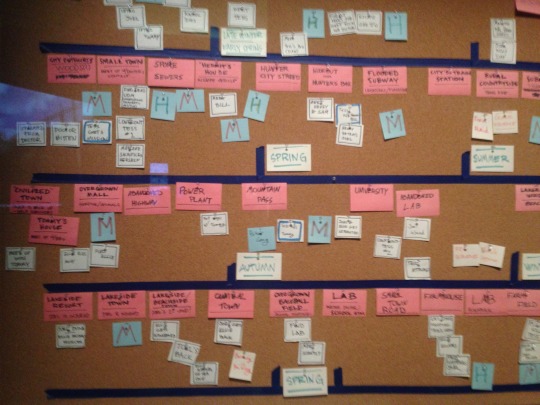
[Corkboard plotting out events + setpieces across the timeline of The Last of Us]
As an exhibition space, it is made with the fact that multiple people are occupying it at the same time in mind. If something is not available you can engage with something else. And if one type of engagement is not to your tastes there’s a good chance something else will be- not bothered about the wiki used to help the team of KR0 to communicate? Maybe you’ll be more interested in some of Ben Babbit’s sonic improvisations, or the visual inspirations involved in the creation of the game.
There’s more I could talk about wrt this first sections layout of how it winds you around instead of giving you a straightline to the exit, the choice of games playable being fundamentlly simple, an anecdotally sweet image of a child holding the obscenely big original xbox ‘duke controller’ on a pedestal and their dad cradling their hands. But I’ll just leave off this post here for now and maybe continue looking at V&A things and posting about it later.
To be continued..?
2 notes
·
View notes